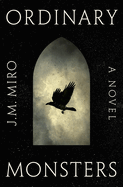
J.M. Miro's Ordinary Monsters is the wholly original, haunting first installment in a historical fantasy series filled with monsters and magic, set amid disturbingly real dark corners of humanity. This epic novel takes the Victorian gothic aesthetic of its 1880s London setting and re-invents its lore on a global scale.
Marlowe was found as a baby in a freight car. He has remained safe and alive, traveling from London to San Francisco, through the devotion of a series of caring adoptive mothers. Despite their unconditional love, no one can explain how Marlowe is able to emit a blue light and alter people's flesh. Meanwhile, teenaged Charlie Ovid, a mixed-race orphan in the postbellum American South, finds himself in prison after killing a man in self-defense. A mob of white men is eager to kill Charlie, but everyone who has encountered the boy is wary of his inexplicable ability to heal any wounds he incurs.
Alice Quicke and Coulton, representatives of the mysterious Cairndale Institute in Edinburgh, are determined to find and retrieve both boys. Cairndale presents itself as a haven for these children--called Talents--born with unusual abilities that allow them to act as bridges between the world of the living and the world of the dead. But Alice--new to the institute and its shadowy practices--is not entirely convinced by the woman who employed her, Margaret Harrogate, that Cairndale is what is claims to be. Demons from Alice's past haunt her, and she suspects the answers to her questions can be found at the same place she has been tasked to take these children, and specifically from Cairndale's mysterious owner. As Alice, Coulton and Margaret rush to save Marlowe and Charlie from a fast-encroaching evil, a larger battle begins at Cairndale, one that will determine not just their futures, but the future of the larger world.
The universe of Ordinary Monsters is both complex and atmospheric, fully engrossing in its world-building detail and cinematic execution. Miro's novel has no shortage of moody, steampunk-infused, nightmare-inducing locales: rain-drenched, lantern-lit back alleys in Japan; rat-infested, labyrinthine streets in London; ripped and sagging circus tents in foggy San Francisco; a sprawling Scottish estate on a craggy coast choked with islands. The novel's globe-trotting characters jump from trains to boats to carriages, giving Miro's story not only a great deal of specificity and texture, but also a sense of existing within a fully formed world.
Miro's perfect blending of period detail and unique fantasy lore give this spectacle an engrossing, hypnotic quality. Rather than treading well-worn ground, Miro's vision of the Talents is inventive and ambitious, covering everything from their abilities to their imaginative origins. In this first installment alone, Miro manages to convey a vast history of these powers and the world parallel to ours from which they came without ever slowing the plot's pace. The author packs the novel with action sequences as Alice, Marlowe and Charlie whip from one near-miss to the next. Alice is fearless in her actions, like many of the novel's women, giving the book plenty of opportunities to thrust its central characters into danger. As soon as one breathless encounter is complete, another character from the eclectic cast is sure to be risking their life elsewhere, keeping readers on the edge of their seats.
But while the novel's visually and intellectually stunning world and its fast pace will keep readers turning pages, it is the chemistry and tenderness between its characters that gives Ordinary Monsters its lasting appeal. Charlie and Marlowe are joined by a number of compelling orphan characters whose desire to belong and whose love for each other give even the darkest and more gruesome moments of Miro's book an unexpected hopefulness. Between Charlie's tenacity and loyalty and Marlowe's sensitivity and wonder, it is impossible for readers to be overwhelmed by the disturbing elements of the book--horrifying though they can be. The orphaned Talents themselves are reminders that that which appears most monstrous may actually be a source of good in the world. As one character tells Marlowe at Cairndale, "Anything different from the normal appears monstrous. But it is not. It is not."
The key to the novel's emotional core--which circles these questions of monstrosity, unconditional love and belonging--is motherhood. The mothers who populate Miro's novel are by turns self-sacrificing, negligent, fierce, exhausted and monstrous themselves. Biological and adoptive alike, they may be imperfect, but they are also powerful, able to both save and haunt their offspring and wards. This tension--between what is feared and beloved, valued and rejected, idealized and vilified--gives the world of the Talents its complexity, its heart and its fundamental truths. Clashes between good and evil are never quite as simple as they may appear. To understand that, Miro's book suggests, one need look no further than the figure of the orphan, or for that matter, the figure of its mother. --Alice Martin

